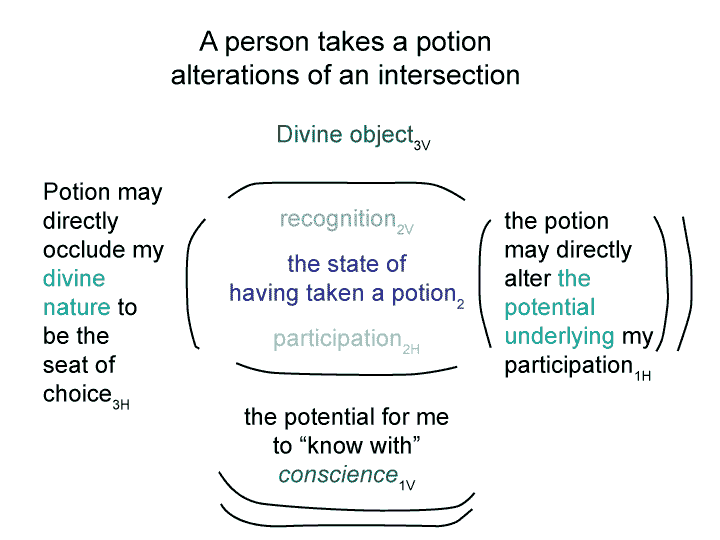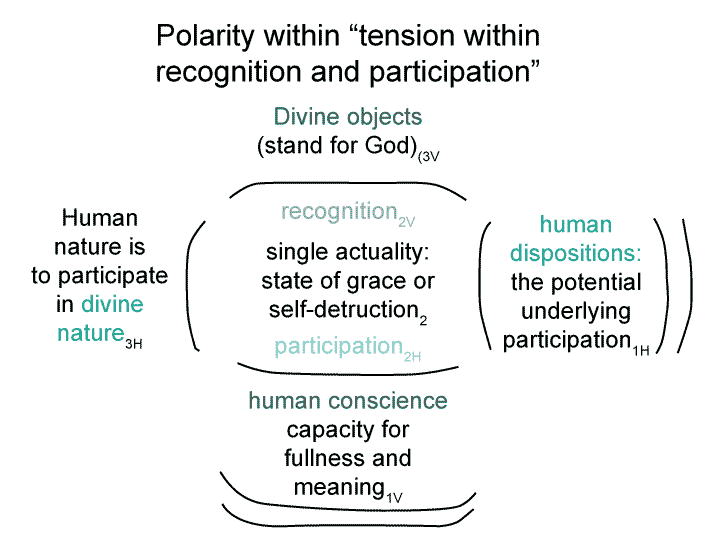Man and Sin by Piet Schoonenberg (1964) 2.1FA
[Schoonenberg sets forth the scenario where:
A person takes a potion.
The potion alters “her” state of existence.
The potion is a metaphor for the actuality of grace (or the actuality of self-destruction).
The scenario is placed into the prior intersection in the following figures.]
Man and Sin by Piet Schoonenberg (1964) 2.1EZ
Summary of text [comment] pages 69 through 71
Schoonenberg gave an example of ‘the person influenced by grace’.
Consider the metaphor of illness. Grace is like a drug that a person has taken. The potion works on the person’s nature, aiding its combat with the illness.
The reverse is true for sin. A person takes a drug that induces ill effects in the person’s nature.
But doesn’t God, at times, bypass a person’s decisions?
What about miracles of healing or punishment?
What about the repercussions of the grace of paradise and Original Sin?
Man and Sin by Piet Schoonenberg (1964) 2.1EY
Summary of text [comment] pages 69 and 70
[The saying goes: A picture tells a thousand words.
‘The intersecting nested form’ and ‘the nested form embedding the intersection’s single actuality’ are pictures. They have inspired many words.
Schoonenberg’s text is dense. He presumes that the reader shares a common cultural understanding. Decades (maybe, even centuries) of controversy are condensed in each line.
These controversies occurred before the dawn of the Age of Semiotics.
These controversies set the stage for the Age of Semiotics.
Nested forms present visual models for ways that ‘the diverse elements of Schoonenberg’s discussion’ could fit together. My speculations may or may not be on target.
So what is the advantage?
The target belongs to this sign-filled age of understanding.]
Man and Sin by Piet Schoonenberg (1964) 2.1EX-2
[If grace is an actuality, then may be modeled as the single actuality in the intersection.
So may self-destruction.
Grace stands in contrast to self-destruction.
Grace, as an actuality, emerges from and situates two potentials.
So does self-destruction.
Natural dispositions are capable of being ruled and molded by each state of existence.]
Man and Sin by Piet Schoonenberg (1964) 2.1EX-1
Summary of text [comment] pages 69 and 70
Schoonenberg wrote that our nature reacts with grace in so far as it is at the disposal of the human person. Natural reactions express “man’s” personal answers in so far as such reactions express such answers.
[To me, the words ‘the natural reaction’ and ‘disposal of the human person’ sound like the horizontal axis of the prior intersecting nested form (the axis of humandivine nature and human dispositions).
The words ‘our personal answers’ and ‘express such answers’ sound like the vertical axis (the axis of divine object and conscience).]
Man and Sin by Piet Schoonenberg (1964) 2.1EW
Summary of text [comment] page 69
[‘Our states of existence’ (of either grace or self-destruction) are tumultuous because they contain contradictions.
On top of that, ‘our states of existence’ face apparently incompatible normal contexts. A divine object (such as an idol) may be incompatible with our human nature (to participate in divine nature; such as, triadic relations). Normal contexts obey the laws of exclusivity. The incompatibilities, manifested as contradictions in ‘our states of existence’, may drive conversion from one exclusive normal context to another.
The tension between the normal contexts and the realms of possibility constitutes a God-source and human-subject polarity within the intersection.
Finally, ‘our states of existence’ belong (as an actuality) in a content-level nested form. This content-level form describes the person. However, this nested form is not articulated. It models the person’s unconscious.
Thus, Schoonenberg’s word ‘counterpole’ is rendered as both ‘God-source and human-subject’ and ‘God-source and human-subject within the person’.]
Man and Sin by Piet Schoonenberg (1964) 2.1EU
[When participation no longer situates recognition. ‘what we recognize as ourselves’ and ‘what we do’ clash in a single actuality.
God (the source pole corresponding to both normal contexts) brings the human subject (the subject pole corresponding to both possibilities), into relation with an actuality that may be described as ‘a state of existence’ (corresponding to the single actuality of participation and recognition).
‘Our states of existence’ (of either grace or self-destruction) are filled with contradictions. Yet, they operate under the laws of non-contradiction. They are contextualized by two exclusive normal contexts. They are grounded in two upwellings in the monadic sea of possibility (conscience and dispositions).]
Man and Sin by Piet Schoonenberg (1964) 2.1ET
Summary of text [comment] page 69
[When these nested forms do not interscope, they intersect.
‘God Recognizing Himself’ creates and sustains three categories of existence.
Our human disposition prepares us to participate in ‘the triadic structure of existence’. We assume that the triadic structure of existence is actual. We attend to relationships, artifacts and potentials.
But sometimes, participation does not situate recognition. We are always surprised and disarmed when we perform some act with apparently no normal context. We participate without recognition. We are also miserable when we are forced to do activities that do not fit our self-recognition.
Often, in our current Lebenswelt, sovereign religions force their objectorganizations upon us. They lie to us in the hope that we will recognize ourselves within the mirror of their objectorganization.
Forced participation. False recognition.]


